Related Research Articles

Oveta Culp Hobby was an American government official and businesswoman who served as the first United States secretary of health, education, and welfare from 1953 to 1955. A member of the Republican Party, Hobby was the second woman ever to serve in a presidential cabinet.
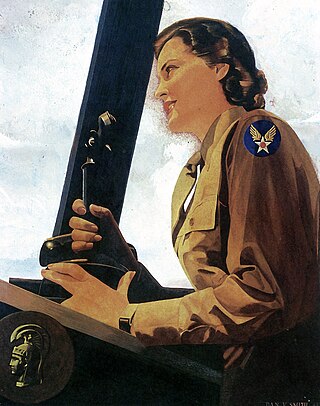
The Women's Army Corps (WAC) was the women's branch of the United States Army. It was created as an auxiliary unit, the Women's Army Auxiliary Corps (WAAC) on 15 May 1942 and converted to an active duty status in the Army of the United States as the WAC on 1 July 1943. Its first director was Colonel Oveta Culp Hobby. The WAC was disbanded in 1978, and all units were integrated with male units.
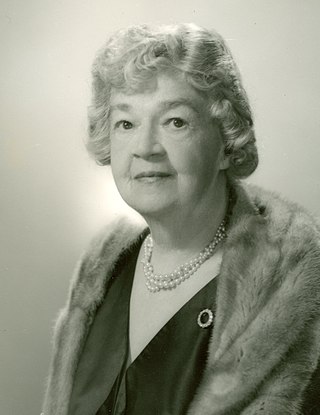
Edith Rogers was an American social welfare volunteer and politician who served as a Republican in the United States Congress. She was the first woman elected to Congress from Massachusetts. Until 2012, she was the longest serving Congresswoman and was the longest serving female Representative until 2018. In her 35 years in the House of Representatives she was a powerful voice for veterans and sponsored seminal legislation, including the Servicemen's Readjustment Act of 1944, which provided educational and financial benefits for veterans returning home from World War II, the 1942 bill that created the Women's Army Auxiliary Corps (WAAC), and the 1943 bill that created the Women's Army Corps (WAC). She was also instrumental in bringing federal appropriations to her constituency, Massachusetts's 5th congressional district. Her love and devotion to veterans and their complex needs upon returning to civilian life is represented by the Edith Nourse Rogers Memorial Veterans Hospital in Bedford Massachusetts that is named in her honor.

The Women Airforce Service Pilots (WASP) was a civilian women pilots' organization, whose members were United States federal civil service employees. Members of WASP became trained pilots who tested aircraft, ferried aircraft, and trained other pilots. Their purpose was to free male pilots for combat roles during World War II. Despite various members of the armed forces being involved in the creation of the program, the WASP and its members had no military standing.

Mary Agnes Hallaren was an American soldier and the third director of the Women's Army Corps (WAC) at the time that it became a part of the United States Army. As the director of the WAC, she was the first woman to officially join the U.S. Army.
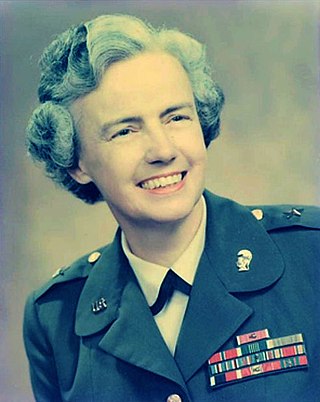
Elizabeth Paschel Hoisington was a United States Army officer who was one of the first two women to attain the rank of brigadier general.
Women's Armed Services Integration Act is a United States law that enabled women to serve as permanent, regular members of the armed forces in the Army, Navy, Marine Corps, and the recently formed Air Force. Prior to this act, women, with the exception of nurses, served in the military only in times of war. During World War II, over 150,000 women had served in the WAVES and the Women's Auxiliary Army Corps and were still serving when the act was enacted. Women also took part in the SPARS, which was created by the Coast Guard, and the Marine Corps Women's Reserve, during the war. In total, 350,000 American women joined and served during World War II. Section 502 of the act limited service of women by excluding them from aircraft and vessels of the Navy that might engage in combat.

Fort Logan National Cemetery is a United States National Cemetery in Denver, Colorado. Fort Logan, a former U.S. Army installation, was named after Union General John A. Logan, commander of US Volunteer forces during the American Civil War. It contains 214 acres (87 ha) and has over 122,000 interments as of 2014. It was listed on the National Register of Historic Places in 2016.

Cornelia Clark Fort was a United States aviator who became famous for being part of two aviation-related events. The first occurred while conducting a civilian training flight at Pearl Harbor on December 7, 1941, when she was the first United States pilot to encounter the Japanese air fleet during the Attack on Pearl Harbor. She and her student narrowly escaped a mid-air collision with the Japanese aircraft and a strafing attack after making an emergency landing.
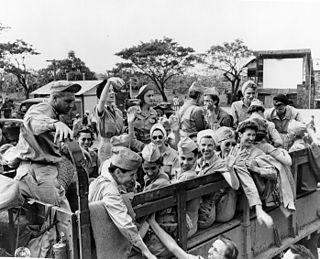
The Angels of Bataan were the members of the United States Army Nurse Corps and the United States Navy Nurse Corps who were stationed in the Philippines at the outset of the Pacific War and served during the Battle of the Philippines (1941–1942). When Bataan and Corregidor fell, 11 navy nurses, 66 army nurses, and 1 nurse-anesthetist were captured and imprisoned in and around Manila. They continued to serve as a nursing unit while prisoners of war. After years of hardship, they were finally liberated in February 1945.
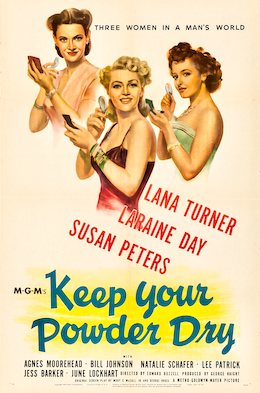
Keep Your Powder Dry is a 1945 American drama film directed by Edward Buzzell and starring Lana Turner, Susan Peters, and Laraine Day. Its plot follows three women who join the Women's Army Corps during World War II. The screenplay was written by George Bruce and Mary C. McCall, Jr.

The United States Army Nurse Corps (USANC) was formally established by the U.S. Congress in 1901. It is one of the six medical special branches of officers which – along with medical enlisted soldiers – comprise the Army Medical Department (AMEDD). The ANC is the nursing service for the U.S. Army and provides nursing staff in support of the Department of Defense medical plans. The ANC is composed entirely of Registered Nurses (RNs) but also includes Nurse Practitioners.
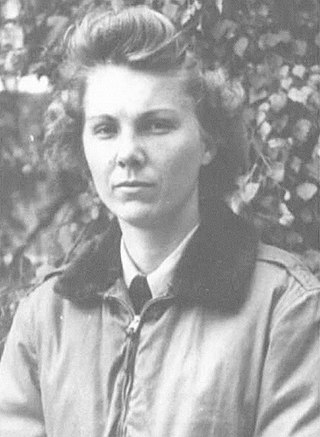
First Lieutenant Reba Zitella Whittle was a member of the United States Army Nurse Corps during World War II. She became the only American military female prisoner of war in the European Theater after her casualty evacuation aircraft was shot down in September 1944.

Mary Elizabeth Clarke was a United States Army officer who was the department head of the Women's Army Corps. She became major general in the United States Army and was the first woman to obtain this rank. She served in the United States Army for thirty six years, the longest ever served for a woman in the United States Army. In 1978 Norwich University awarded her an honorary doctorate in military science. She retired in 1981 and was on the Women in the Services Defense Advisory Committee.
This is a timeline of women in warfare in the United States from 1900 until 1949.

American women in World War II became involved in many tasks they rarely had before; as the war involved global conflict on an unprecedented scale, the absolute urgency of mobilizing the entire population made the expansion of the role of women inevitable. Their services were recruited through a variety of methods, including posters and other print advertising, as well as popular songs. Among the most iconic images were those depicting "Rosie the Riveter", a woman factory laborer performing what was previously considered man's work.

There have been women in the United States Army since the Revolutionary War, and women continue to serve in it today. As of 2020, there were 74,592 total women on active duty in the US Army, with 16,987 serving as officers and 57,605 enlisted. While the Army has the highest number of total active duty members, the ratio of women-men is lower than the US Air Force and the US Navy, with women making up 15.5% of total active duty Army in 2020.
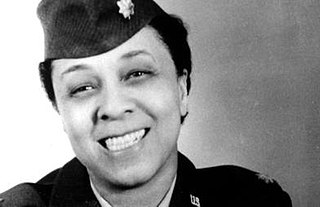
Oleta Lawanda Crain was an African-American military officer, federal civil servant, and advocate for black women's rights and desegregation. Out of 300 women nationwide who entered officer training in the U.S. military in 1943, she was one of the three African Americans. She served in the United States Air Force for 20 years, retiring with the rank of major. In 1964 she began working for the United States Department of Labor in Washington, D.C., becoming regional administrator of its Women's Bureau in Denver, Colorado, in 1984. She traveled and spoke extensively to women about employment rights, wages, and career opportunities. She received numerous awards and honors, and was inducted into the Colorado Women's Hall of Fame in 1988.

Marion Cotton Loizeaux was an American physician who served in World War II, and worked with veterans' program after the war. The New York Times described her as "the only woman surgeon with the United States Army in the European Theatre of Operations" in 1943.

Margaret Janeway McLanahan was an American physician who served in World War II. The New York Times described her as "the first woman doctor in the United States Army in the North African theatre".
References
- ↑ Monahan & Neidel-Greenlee 2010, p. 169-170.
- 1 2 3 Monahan & Neidel-Greenlee 2010, p. 170.
- 1 2 3 Lazell, Fred (30 September 1963). "What Has Happened to Them?". Des Moines Tribune. Retrieved 27 September 2019– via Newspapers.com.
- 1 2 Monahan & Neidel-Greenlee 2010, p. 169.
- 1 2 3 4 5 "Colo. Woman Honored by VA". Orem-Geneva Times. 11 September 1980. Retrieved 27 September 2019– via Newspapers.com.
- ↑ Evans, R.C. (17 June 1977). "Federal File Folder". The Journal Herald. Retrieved 27 September 2019– via Newspapers.com.
- ↑ "Women Pilots Demand Equal Veterans Benefits". Sioux City Journal. 30 May 1977. Retrieved 27 September 2019– via Newspapers.com.
- 1 2 "CPT Dorothy L. Starbuck". Military Hall of Honor. Retrieved 2019-09-28.
Sources
- Monahan, Evelyn M.; Neidel-Greenlee, Rosemary (2010). A Few Good Women:America's Military Women From World War I to the Wars in Iraq and Afghanistan. Knopf Doubleday Publishing. ISBN 9781400044344.